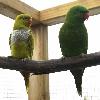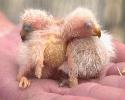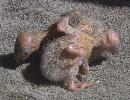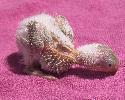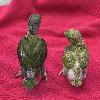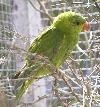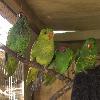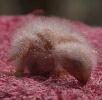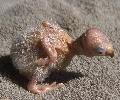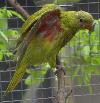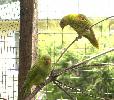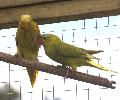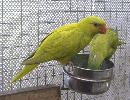Cinnamon Scaly-breasted Lorikeets
Scaly-breasted Lorikeet, Trichoglossus Chlorolepidotus, is a
medium sized lorikeet (22cm to 25cm in length).
Colour is an overall green, feathers on chest and shoulders edged in yellow
giving a scaled appearance, tail green and green/yellow under, blue tinge
on head (more prominent in male), underwing red, beak red, eyes red/orange.
Young birds have lighter orange beak and light grey ring in eye that develops
into an orange ring as they get older.
About one in every four to six Scaleys will be of the Olive variety. Less common
are Lutino, Yellow and Cinnamon types and extremely rare are blue Scalys.
These pages of our web site are to provide images of our cinnamon
scaly lorikeets. We were very fortunate to obtain a breeding pair where the
hen was either a yellow, cinnamon or mustard, and we were also able to purchase seven of her offspring,
five greens and two olives. The two olive unfortunately escaped from their
aviary and two of the greens (a hen and cock) were separately sold. This
hen also disappeared before we could raise any chicks from her.
The remaining three greens have been paired up with other birds that have
come from other lutino hens. One pair started breeding in June 2001 but as
yet the other two pair have not.
Colour mutations gives a simplified explanation of how our original pair of Scalies produced their various coloured offspring.
Later in 2001 the other greens were sold leaving us with just this one pair
that produce cinnamon chicks.
It is this one breeding pair that have now produced four greens and
two cinnamons.
Each time they have laid two fertile eggs:
August 2001 saw the first cinnamon chick hatch along with a normal green. This
cinnamon has yellow plumage overlaid with light (lime) coloured green;
October 2001 one chick died while hatching, the other is much more yellow
coloured cinnamon with very sparse green over the yellow plumage;
December 2001, again one chick died while hatching, the other was a green;
Two more chicks hatched in late March 2002. Both survived and are greens.
In April 2002 an opportunity arose to obtain two adult yellow/cinnamon hens
along with a male that was described as green with a yellow back. A pair of
greens that were the parents of one of these yellpw hens was also obtained.
It is most likely that the male green is a split cinnamon, assuming sex-linked
colour gene inheritence rules apply here.
Also, after a visit to another breeders aviaries, where there was a cinnamon
hen paired with a grey-green (olive) male who had produced two chicks, it was
agreed to purchase these as any male chick will likely be split cinnamon -
again assuming the sex-linked rules, this will introduce another
blood line.
When the five scalies arrived the peculiar male was indeed mostly normal
green but with an overlaying, somewhat patchy, of yellow feathers through
his tail and mostly on the back of his body and wings. I am guessing this is
indeed a cinnamon male. He appears to be attracted to one of the yellow/
cinnamon hens and spends most of his time near her although she is not
completely interested in him yet. This yellow/cinnamon hen has raised young
before but she was paired with a rainbow lorikeet, the breeder may have been
trying to introduce the yellow gene to rainbows. Hopefully these two will get
together and produce yellow/cinnamon chicks.
29 May 2000.
Today a new squadron of Scalies arrived. A four year old breeding pair with
a yellow (or possibly mustard or cinnamon) female and a normal green male,
and five of their offspring
between a 5 months and a year old, all normal green scalies.
This is the first yellow, cinnamon or possibly mustard Scaly we have seen.
None of her offspring have been yellow/cinnamon with all being either normal greens or olives.
May 2001.
Sadly this month we lost our yellow female Scaly. She had been nesting
and sitting on two eggs so had not been missed for several days. Eventually
when the nestbox was inspected she was not there. We are not quite sure
what has happened to her, she may have escaped unnoticed.
click on image below to display full size
September to December 2001
Much to our complete surprise we were told that one of two baby Scalies that
were just hatched in the last few days of July 2001 was going to be different
to the usual green or olive type.
This was
after posting 3 day old baby pictures on the Lorylink mailing list. Although
the babies eyes are closed there was a very distinct red colour to the skin
covering the eyes of one baby.
The biggest surprise with this is that the parents are both normal green
Scalies although each has come from a yellow hen. (we are not sure if these
were actually Lutino, Cinnamon or Yellow). The green hen came from
our cinnamon hen which was lost earlier this year.
Once its eyes were open it obviously had bright red eyes and as it developed
the feathers were not coming out the normal green or olive colours. Instead
of being the expected yellow colour there was a mix of lime green coloured
and yellow feathers with tinges of red around the head. After further mailing
list messages it was suggested this bird was a cinnamon or cinnamon mutation.
This is apparently quite unusual. This bird is now almost fully grown and is in
excellent health.
click on image below to display full size
September to December 2001
..and again! The pair of green Scalies that produced the cinnamon have done it
again. Another baby with red eyes but as it developed during
November and December 2001 it becamse clear that this one was indeed much
more yellow than the first cinnamon tched several weeks ago. However, it is
another cinnamon or cinnamon mutation.
This baby was removed from its parents after two weeks as they appeared to
be only partially feeding it. It was immediately placed in an incubator with
a same age baby Yellow-bib and they kept each other company. This cinnamon
has now fully developed to a beautiful quite yellow cinnamon adult with
tinges of red in it tail feathers and hints of red on its face and chest areas.
click on image below to display full size
April 2002
Below are images of the two new yellow/cinnamons we obtained this month
and the green/yellow cock bird. The two yellows are hens, one has red eyes
and both have a very slight green tinge on their heads and backs - proving hey
are not pure yellows or lutinos. There is distinct red on the face of each
below their eyes and around the beaks. Red tinges can also be seen in the
tail feathers and chest areas.
click on image below to display full size

contact us .
Page owner: <dgd@kcbbs.gen.nz>
Last modified: 21 April 2002.
